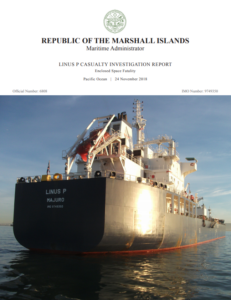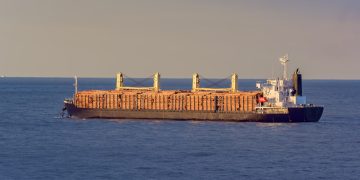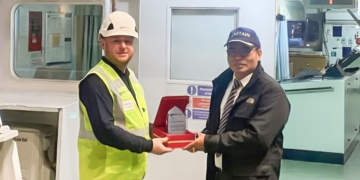A crew member lost his life after entering an enclosed space onboard the oil/chemical tanker LINUS P in an attempt to rescue another crew who had lost consciousness, in November 2018. The Republic of the Marshall Islands issued an investigation report on an enclosed space fatality onboard, identifying failure in following enclosed space entry and other procedures.
The incident
The Republic of the Marshall Islands-registered oil/chemical tanker LINUS P was cleaning cargo tanks while underway off the west coast of the US on 24 November 2018.
At about 0030, an Able Seafarer Deck (ASD) 1, together with the Pumpman, was supplying fresh water to the No. 2 Port (P) Cargo Tank using a fire hose through the open tank dome.
During this work, he dropped his portable radio into the tank. The Pumpman reported that the ASD1 told him he was going to retrieve the radio from the tank after getting a flashlight.
The Pumpman reported that he tried to stop the ASD1 from entering the tank.
The ASD1 entered the inerted cargo tank to retrieve the radio without following onboard enclosed space entry procedures and the lack of oxygen quickly rendered him unconscious.
During the enclosed space rescue operation, the Second Officer (2/O) and ASD2, lost consciousness when they removed their self-contained breathing apparatus (SCBA) face masks while inside the cargo tank.
As a result, the ASD2 fell from the second platform of the tank access ladder to the tank top. All three individuals were subsequently removed from the tank.
The 2/O and the ASD1 recovered; however, the ASD2 did not survive the injuries sustained from his fall.
Findings
RMI marine safety investigation concluded that the causal factors that contributed to the death of the ASD2 and the injury to the ASD1 were:
- failure of the ASD1 to properly secure his radio while working on deck;
- failure of the Pumpman to take firm actions to “Stop Work” when the ASD1 advised him that he was going to enter the tank;
- failure of the ASD1 to comply with the Pumpman’s warning;
- failure of the ASD1 to follow enclosed space entry procedures when he climbed into the No. 2P Cargo Tank to retrieve his radio;
- failure to follow enclosed space entry procedures when the 2/O entered the tank alone; and
- failure to follow enclosed space rescue procedures when the 2/O and the ASD2 removed their SCBA masks while inside the enclosed space.
Probable causes
The causal factors that likely contributed to the fatality and injury include:
- improper decision making by the Chief Officer (C/O) when he directed opening the domes of inerted tanks for cleaning procedures;
- improper supervision by the Master when he failed to ensure the appropriateness and accuracy of the tank cleaning plan and the risk assessment developed by the less experienced C/O;
- inadequate onboard implementation of pre-task risk identification, assessment, and control procedures;
- inefficient organization and execution of the enclosed space rescue procedures;
- ineffective onboard implementation of “Stop Work” policy when crewmembers observed unsafe actions being taken; 6. ineffective enclosed space entry training; and
- lack of understanding of nitrogen (N2) inhalation dangers
Actions taken
In response to this very serious marine casualty, the Company has taken the following Preventive Actions:
- Shore-side personnel conducted an onboard safety meeting and drill including a discussion of N2 inerted atmosphere hazards and the necessary precautions to take.
- A safety alert was sent to all Company-managed ships to communicate the lessons learned and to require a safety stand-down to discuss relevant SMS requirements, including an immediate restriction on enclosed space entry without prior approval from the office.
- Review and verification of the onboard implementation of the enclosed space entry and rescue procedures, the “Stop Work” policy (including reinforcing the authority of all crew members to exercise their right to stop any action they perceive as unsafe), and requirements to restrict tank dome opening unless tank is gas free.
- An operational circular was sent to all Company-managed ships to discuss the specific hazards of N2, physiological effect of oxygen deficiency on the body, and complete prohibition of opening tank domes of inerted tanks.
- Communication to all Company office staff to check for compliance with enclosed space entry and rescue procedures during all audits and inspections.
- The Company has hired a third party to carry out a “Human Factor Analysis” to assist with implementing measures to prevent a reoccurrence.
Recommendations
Following investigation, the RMI provided the following recommendations:
- The Company incorporate the lessons learned from this casualty into a pre-joining training program, which should also be completed by current crew members to raise awareness.
- The Company implements a pre-joining training program pertaining to the hazards of N2 and the relevant safe work practices, which should also be completed by current crew members to raise awareness.
- The Company review, and update as necessary, the process for addressing and disseminating safety recommendations issued by the Administrator.
- The Administrator considers submitting a proposal to IMO to amend Resolution A.1050(27) to amend the emergency response section in order to better detail the fundamental actions that should be taken during an enclosed space rescue in order to ensure a safe and effective response.
Explore more herebelow:


































































